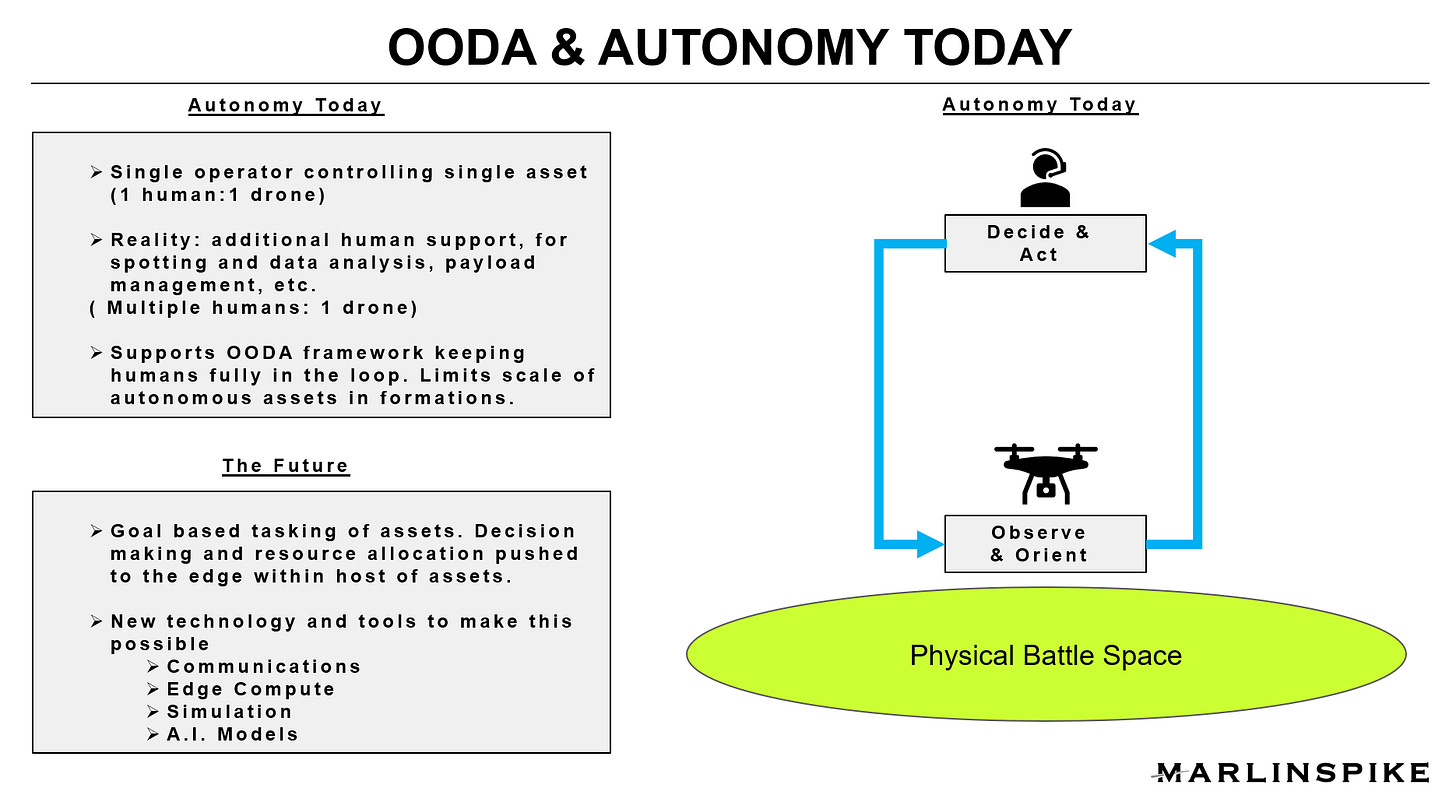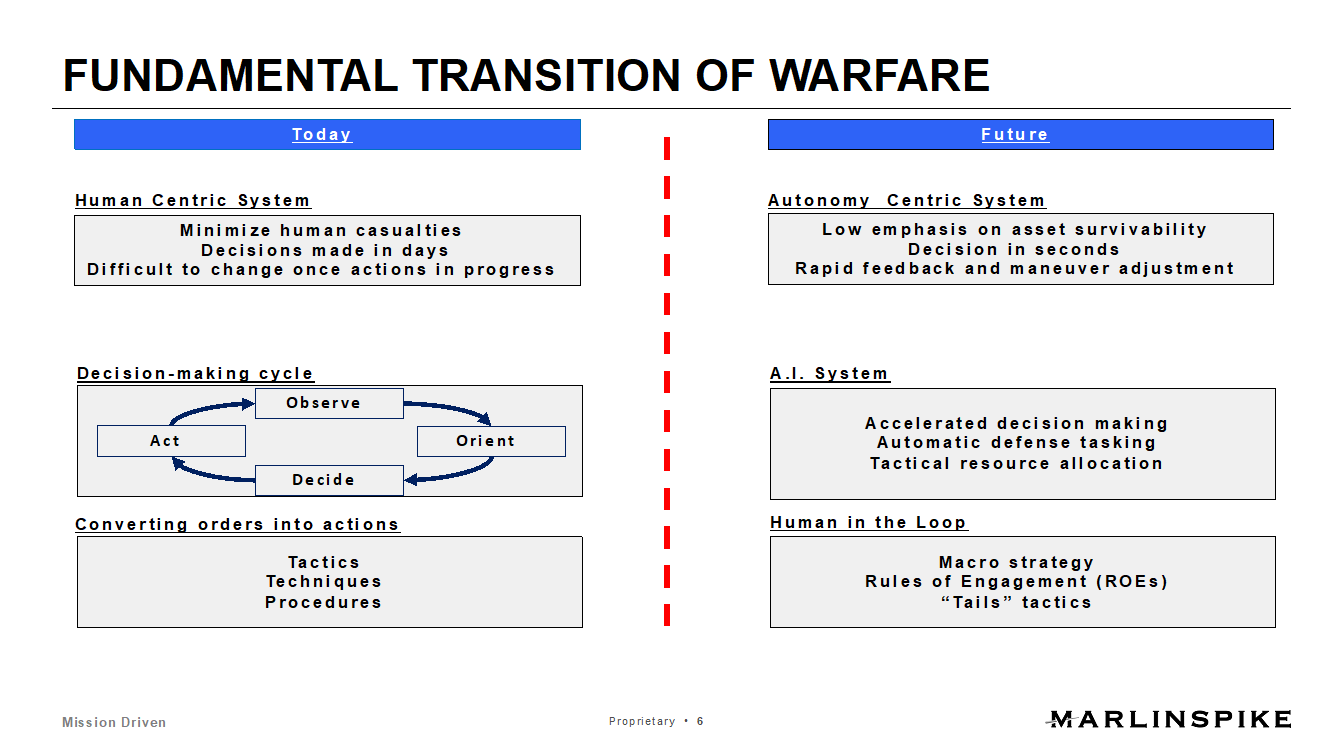Synthetic Data Generation – Key to Autonomy
To fuel autonomy, we must harness synthetic data and wargaming to revolutionize AI-driven warfare
Technological progress is rapidly transforming the nature of warfare. Across the world in theaters from Ukraine, the Middle East, and the Pacific, the intersection of emerging technologies is driving revolutionary changes in capabilities, tactics, and strategy. As fighting transitions from humans to autonomous systems, we need to build an AI layer to take full advantage of autonomy. With cutting edge models being mostly open-sourced, superior performance can only be achieved through superior data - data is the oil that powers AI. To quickly build an autonomous fighting force, we need to quickly acquire large quantities of operational data – data that today does not exist and will probably take years to collect. We are proposing significant investments in wargaming capabilities to synthetically create the operational data needed to train AI models and develop new doctrines and tactics for the deployment of autonomous systems.
Wargaming - History
Military tabletop exercises and planning date back to ancient times. Modern wargaming was first adopted by the Prussian Army in 1820s with exercises called Kriegspiel. Initially, Kriegspiel were used to train the Prussian officer corps on tactics and maneuvers but eventually grew into a complex scenario planning tool. The adaption of Kriegspiel was a major driver of Prussian successes in the Franco-Prussian war of 1870. Following the war, wargaming became an integral part of strategy development around the world. By the 1880s, the U.S. military, particularly the Naval War College, adopted wargaming for its officer training efforts. Throughout the 20th century, most major militaries continued to iterate and evolve wargaming practices. Today, wargaming is indispensable for personnel training, introduction of new capabilities, and contingency planning.
Observe, Orient, Decide, Act (OODA)
Warfighting experience teaches us that the side that has the faster OODA loops wins. Wargaming aims to increase the speed and accuracy of OODA loops, as well as test tactics, techniques and procedures (TTPs). OODA loops create strategy and TTPs convert strategy into maneuvers in the field. TTPs are in place to reinforce the chain of command and ensure disciplined execution of the strategy as orders move down and information from the field moves up the chain of command. This is a very human-centric process requiring multiple layers to ensure the accuracy of execution. This chain of command is poised to be fundamentally disrupted by AI.
AI - Gaming Advances
AI’s ability to play games at a professional level has grown significantly. In 1997, AI Deep Blue beat a reigning world chess champion. By 2016, AI (AlphaGo) had scaled in complexity to defeat world leading players in the Chinese strategy game of Go. By the end of the decade, AlphaStar, an AI-powered intelligence ranked among the 0.2% of the best players of StarCraft II (a strategy video game). Today, AI is competitive with professional gamers in decision making and can easily simulate or execute thousands more variables/commands than a human can.
AI Takes Over
The DoD’s current operational concepts are built around human driven OODA loops and TTPs. Assets are deployed into the field, data is collected and sent back to decision makers who go through the OODA loop to create and issue orders.
In the future, warfare will be fought by autonomous systems controlled by AI algorithms. These algorithms will determine which assets are best suited to execute a mission, develop a plan, and control the execution of the plan. Humans will move out of the loop into an “on-the-loop” role, providing oversight and ensuring that “commander’s intent” is executed. The tempo of operations and the complexity of maneuvers will increase as machines are easier to control than humans.
To implement this new vision, data is key. Data, both real and synthetic, will be used to train and improve the AI models that underpin the decision-making agents creating strategic plans and local AI models controlling autonomous systems. The models themselves will most likely be built using open-source tools.
The starting point for building AI models is access to operational data. But today, there is not enough real-world data to train AI models. Most of the data within the Department of Defense (DoD) today is irrelevant since it is focused on a human-centric force. Generating and collecting the required data in the real world would take a significant amount of time and money before the DoD could effectively implement and scale autonomy. Digital wargaming can be used to fill the gap. Humans can play a couple of rounds and then set two AI agents to play against each other, those AI agents are known as Generative Adversarial Networks– (GANs). As GANs play wargames, synthetic data is generated for training and testing AI models and strategy evaluation purposes. With this approach, we can quickly develop the required data to deploy autonomy at scale in different operating environments. The DoD can leverage developments in commercial gaming engines to advance “dual-use” products. With the rapid increase of available computing power spearheaded by players such as NVIDIA, AMD, and the cloud hyperscalers – the accuracy of simulations and gaming engines is increasing exponentially as the private sector continues to invest billions into gaming R&D.
AI + Autonomy > Humans
Using wargaming capabilities, synthetic environments can be created to mirror real-life scenarios, not only to generate data, but also to test new warfighting doctrines and tactics. The philosophy and cost benefit analysis of fighting with attritable systems is very different than the human centric conflicts being fought today. Losses with attritable systems are nothing more than accounting lines, offering commanders a wider scope of action. Algorithms that govern attritable systems could make a calculated decision to advance through a minefield even if it is highly likely that losses will destroy most of the force. Such a course of action is neither available nor practical with humans as the primary drivers in conflict. Increased capabilities in edge computing and deployment of wargaming “environments” into the battlespace will allow commanders in the field to collect data and fuse real-world data with synthetic data from gaming engines, update AI models, and simulate AI generated war plans. Such a force consisting of AI and autonomous systems would quickly outmaneuver and overwhelm human opponents.
The benefit of wargaming would not only be restricted to defense, the same wargaming software can be used to test crisis management systems (nuclear incidents, natural disasters, civil unrest, etc.), improve resource planning (telecom networks, supply chains, critical infrastructure capabilities, etc.) and/or assist with policy development.
Role of Humans in Wargaming
While we generally understand how AI models function, those models are non-deterministic. The non-deterministic nature implies that humans will need to oversee the effective use and deployment of AI models. In addition to providing oversight, humans would need to approve any plan requiring kinetic action. Much like the deployment of cruise missiles or artillery – the human operators initiate firing, but once deployed, the missile or shell executes the mission autonomously. Autonomous systems operated by AI would have the same operational concept, but instead of plotting a flight path, humans would provide the intent (goal, i.e. scan this area), targets (e.g. enemy firing positions) and rules of engagement (mission constraints). Once deployed, the allocation and execution would be handled by AI models embedded across the fleet of assets.
In this new future, data will be king. Data is the foundation of AI as AI can only “create” based off the data used in training. As a result, the need for human creativity will not disappear, in fact creativity will become more important. Only humans can devise unconventional “tail” tactics that would never fall under the “normal” course of action – military history is full of examples where leaders risked it all on a move deemed to be impossible or unconventional, only to be proven right.







It's a very real scenario in the phantom fascilitation of gangstalking RNM , synthetic telepathy